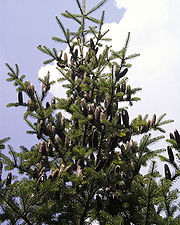Balsam Fir
| Habit | tree
| |
|---|---|---|
| Height: | ⇕ | 15 m"m" can not be assigned to a declared number type with value 15. |
| Width: | ⇔ | 4.5 m"m" can not be assigned to a declared number type with value 4.5. |
| Lifespan: | ⌛ | perennial |
| Origin: | ✈ | C & E Canada, NE US |
| Exposure: | ☼ | sun |
|---|---|---|
| Water: | ◍ | moist |
| Features: | ✓ | fragrance |
| USDA Zones: | 3 to 8 | |
| Sunset Zones: | 3-7, 15-17, 36-38, 42-44 |
|
Pinaceae > |
Abies > |
balsamea > |
Abies balsamea - Balsam Fir. Pyramidal tree up to 50ft tall with dark green needles. Doesn't thrive in hot-summer climates. Has legendary fragrance, making it popular for wreaths and Christmas trees.
The balsam fir (Abies balsamea) is a North American fir, native to most of eastern and central Canada (Newfoundland west to central Alberta) and the northeastern United States (Minnesota east to Maine, and south in the Appalachian Mountains to West Virginia).[1]
It is a small to medium-size evergreen tree typically 14 - 20 m tall, rarely to 27 m tall, with a narrow conic crown. The bark on young trees is smooth, grey, and with resin blisters (which tend to spray when ruptured), becoming rough and fissured or scaly on old trees. The leaves are flat needle-like, 15 to 30 millimetres (½–1 in) long, dark green above often with a small patch of stomata near the tip, and two white stomatal bands below, and a slightly notched tip. They are arranged spirally on the shoot, but with the leaf bases twisted to appear in two more-or-less horizontal rows. The cones are erect, 40 to 80 millimetres (1½–3 in) long, dark purple, ripening brown and disintegrating to release the winged seeds in September.
Read about Balsam Fir in the Standard Cyclopedia of Horticulture
|
|---|
|
Balsam Fir. Balm Of Gilead Fir. Tree, 50-80 ft.: trunk 17-30 in. in diam.: lvs. dark green and lustrous above, pale below, rounded or obtusely short-pointed and occasionally emarginate, acute or acuminate on fertile branches: cones oblong, cylindrical, purple, 2.5-4 in. long; bracts shorter or rarely slightly longer than their scales. E. N. Amer. from Labrador and the valley of the Athabasca to Iowa and the mts. of Va. —Wood occasionally used for lumber; Canadian balsam, or balsam of fir, is obtained from the bark; in cult, loses its beauty early. The above text is from the Standard Cyclopedia of Horticulture. It may be out of date, but still contains valuable and interesting information which can be incorporated into the remainder of the article. Click on "Collapse" in the header to hide this text. |
- More information about this species can be found on the genus page.
Cultivation
Propagation
Pests and diseases
Varieties
There are two varieties:
- Abies balsamea var. balsamea (balsam fir) - bracts subtending seed scales short, not visible on the closed cones. Most of the species' range.
- Abies balsamea var. phanerolepis (bracted balsam fir or Canaan fir) - bracts subtending seed scales longer, visible on the closed cone. The southeast of the species' range, from southernmost Quebec to West Virginia. The name 'Canaan Fir' derives from one of its native localities, the Canaan Valley in West Virginia. Some botanists regard this variety as a natural hybrid between balsam fir and Fraser fir (Abies fraseri), which occurs further south in the Appalachian mountains.
From other sources:
- 'Nana' is a dwarf variety good in rock gardens and containers.
Gallery
References
- ↑ "PLANTS Profile for Abies balsamea (balsam fir)". Retrieved on 2007-07-17.
External links
- w:Balsam Fir. Some of the material on this page may be from Wikipedia, under the Creative Commons license.
- Balsam Fir QR Code (Size 50, 100, 200, 500)
